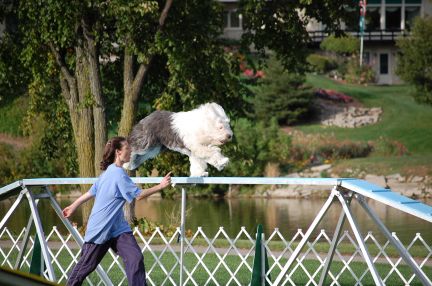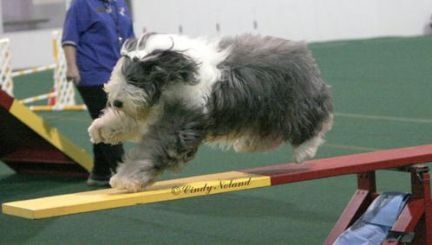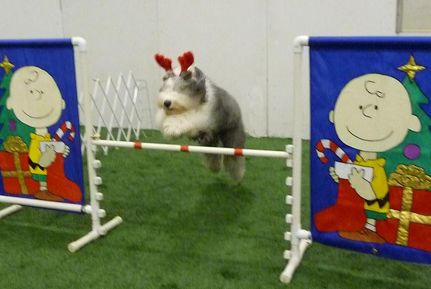
To bob or not?
We also talked about it pertaining to sheep because sheep tails are as long as OES tails, drag on the ground, and are docked the same as OES tails. For sheep farmers tend to take the hot iron and cut the tail off. It sounds awful, but this is actually the least painful (little pain involved) and most sterile way (it seals and disinfects the wound) to do it. My question/debate you everyone is do you think OES SHOULDN'T be docked. Thus, the tails should always be left on regardless and why? I find that most people do, but not really for scientifically or reasonably founded reasons, usually just anthropomorphic reasons. Such as seeing the tail equivalent to your arm and knowing how you would feel without an arm. But a dog's tail is not equivalent to an arm and all animal tails are different. For example, cows can't even feel their tails and when you cut them off they don't feel a thing (They do this in very muddy areas to help keep the cows clean- i don't agree with it because the animals lose the ability to repel insects- but that's another story). As an aspiring animal behaviour and welfarist/ vet i like to look at the pros verses cons to anything. I should mention, I don't have a problem with OES tails or bobbed, but i do think people should have the CHOICE for either way on their dog. Unlike ear propping, which I've yet to find a medical pro for, and which is much more painful than tail docking. There is little pain in dog tail docking (or no evidence to prove sufficient pain) PROVIDED it is done in a timely manner. Puppies must have their tails docked by 2 days of age at the latest. After two days the tail turns from cartledge to bone. Before that the pain is equivalent, in an anthropomorphic way, to piercing a human babies ear. thus, my first pro is that there is little pain involved with the procedure. Not as little as docking a cow's tail, but still very little. Second, OES' were once working dogs and their tails were docked for the same reason sheep's tails were and still are docked- to prevent fly strike. This is where feces builds up on the back end of the animal (it often happens to our OES' and we have the docked-feces not the disease lol) and a green bulbed fly will lay it's eggs in the feces on the animal. Once the eggs hatch they will burrow into the flesh of the animal and start to burrow deeper and deeper and basically eat the animal under it's flesh. It's deadly for the animal and an excruciatingly painful and 'disgusting' disease which needs immediate vet attention. By docking sheep's tails they prevent this and that's why OES tails were originally docked as well I do believe, but no quotes here, though it does seem highly likely. In addition to that fact they drag their tails on the ground and it keeps the animal that was always out with the sheep slightly cleaner. Actually, matted hair which is common in OES may also lead to this, so it's super important to daily comb your OES and i know there are tonz of groomers here that would agree with that point so my second pro is that it potentially can prevent health problems. My main negative is animal behaviour. Tails are critical to in-depth signaling and communication in dogs. Now they aren't in any way essential since dogs have a very complex communication system. But their highly important in long distance signals- in a short term time basis (scents are important in long term distance signals). So long as a dog can bark and move other body parts however it isn't being cut-off at the knees signal wise. But at the same time we still don't know very much about dog behaviour in general definitely not the specifics. So this may be a bigger negative than we even know. So my general opnion is that we really should dock most tails because it's not that painful (if done right), it eliminate the health risk once combined with the great grooming i know every OES owner on this board is giving their dogs and severely limits it for the dogs not getting top rate care. Also something i didn't mention, i fear that if we aren't allowed to dock these animals tails the breeds may be in danger. Many people get OES just to try is out, their something different. These dogs have big and powerful tails. tails that an unprepared non OES fanatic may not be properly prepared for! IF the tail causes people to decline their owner ship the breed with start to dwindle. That worries me a bit as it's such a wonderful breed. But people in general are lazy animals and this really could affect the breed. Once again, by no mean am i saying the dog HAS to be docked. I think it should be the family's choice. But you should have the option to dock the animal's tail if you really want to. you should also have the option to leave it on- their darlings and cute either way But what i want to know is as OES experts yourselves (which everyone here is), what's your opinion's on this? I think it would just be interesting to hear what others think about this |
|
|
| Wow. You actually put some serious thought into this.
In terms of the tail's impact on other dogs' ability to read a dog, though it's won't be scientific, it would perhaps help to ask the long time breeders from areas where they are no longer permitted to dock if they noticed: (a) that their docked OES from years gone by were particularly prone to misunderstandings vis-a-vis other dogs and, if yes, (b) do these incidents appear to have diminished for their non-docked OES? I've never had to live with a non-docked dog, but I do have a couple of interesting (albeit numerically not sufficent to draw conclusions) observations: I train & compete in agility, a place were you are apt to encounter many high drive and dare I say the occasional unhinged I always ran her in coat. She is a white headed bitch with significant shawl but no splashes. Here she is coming out of retirement for a specialty, so less coat than she had as a youngster: 
My second agility bitch, niece of my eldest, was still in show coat when I started trialing her a little. Also docked, Main difference was that she has more dark on her head. In all the time she was out, only one dog - a BC with known dog issues - ever reacted to her. But he reacted severely. Worse than anything I'd ever experienced before and on multiple occasions. Here she is in coat, though post-finishing, so pretty shaggy: 
I later ran her in a puppy cut (see the adult in my avatar) We never ran into her nemesis in that state, unfortunately. Otherwise, some of the same dogs who would flip out when they saw her aunt never gave her a second glance. At first my theory centered on the massive coat being the culprit. I forgot that I had started running her before she finished her breed championship. Just a few weeks ago I started competing with her daughter. She is "in coat" (not nice coat as she is a pig, but there's enough of it to qualify) See below (eh, antlers optional, but, no, no dogs reacted to these either, although several people did 
She is the (also) the puppy depicted in my avatar. A very (!!) dark bitch with a full mask. Not only has she yet to elicit any reaction from the customary suspects, we even ran into the BC who HATED her mother on sight, and though I can't say he was friendly, he and his handler were seated maybe 8 feet from us and he never reacted to her once... 
I honestly don't know what to make of this but I'm beginning to wonder if a tail (or not) is not the biggest signalment in terms of the outline of a dog or in communicating the dog's intention. I agree it should be important, but then what do these other experiences tell us? I would dearly love to know. But, then, again, I would also need more data. Kristine |
| hehe, their all beautiful Yeah, I just did a paper on the evolutionary development of barking behaviour in dogs. Another group did theirs on tail wagging in dogs. They came second in the class (we came third). I should check into their papers and see what research they found on it. The only thing i know for sure is that dogs are the oldest domestic animal yet the least researched and understood. For example we have NO idea what they should be eating between 2 years and 8 years. People are so against research in dogs that no pet company will fund any research with any kind of invasive measures. invasive being as simple as taking a blood sample. It kinda makes me sick when i hear people paying outrageous prices for maintenance dog food when the pet companies don't have a clue what they should be putting in their. But I digress as I plan to save that for another post topic ~_^. I think a lot of signaling is by scent and ultrasound (sound above what we can hear). so the tail is important but so are the above two. I also think posture, especially of the head, are critical signals. It's a really interesting area for animals in general. I find it's important for humans to understand how different animals communicate with one another. Once I learned how horses talked to each other i had a MUCH easier go when re-training the abused horses that were coming my way. I was purely dog training on horses, but horses are shy, push-over, prey animals and use totally different communication systems. For example, patting is a predator affection signal and dogs love it, but horses HATE it. beyond cats, prey animals tend to stroke for affection and prefer it to the predator patting. It's a small point, but critical when your working with an abused untrustworthy and LARGE animal. Anything to make them more comfortable is worth it Anyway, I'll see if i can find some of the research on tail wagging in dogs for you and maybe if my prof will let me see their papers I'll send them your way if you're interested |
| Do I think the tails should be docked? I personally dont care. I would like the breed either way. I do like the docked tail for a few reasons:
1. They dont clean off a coffee table with one wag of the tail. 2. They are big dogs so the addition of a tail would be more brushing. 3. I like watching his bum wiggle when he gets excited, cracks me up. That being said, I also have seen photos of OES with tails (most in Europe) and I love it. The tail would only add a 10- 15 minutes of extra brushing if the coat was well maintained. So not that big of a deal there. The tails were removed back in the day to acknowledge that it was a working dog. The owner got a tax break if the tail was docked. Not so sure it had anything to do with preventing fly strike. Could be wrong on this, but I think I'm right. As for cleaning the rear end of an OES, deal with it. If you own one you at some point will either get a hose and clean or grab some baby wipes and clean, depending on mess and temp outside. You can wipe a babys butt, you can wipe your dogs, poop is poop no difference. Obe's rear gets checked daily and usually once a week I have to clean it with a wipe. Takes me two seconds to wipe then a quick brush and gone good as new. There is a breed standard that owners/show dogs have to abide by. If a breeder feels that a certain dog is of show quality and the standard is tail docked then tail gets docked. I dont think there is way to tell if a new pup is of show quality at two days old so tails docked here in America. Others with way more experience will chime in I'm sure. Just putting in my two cents. |
| Personally I would prefer to have the tail docked (would even like to have the newfies tail docked some days I have docked lambs tails - they yell more when they get their vet check up or shots if needed. I don't think at two or three days it is an inordinately traumatic experience. do I think it impacts their communitcation with other dogs? Alone - it might a little, but face it we also have dogs with no visible eyes, barely if at all visible ears and a "hidden" body under all that coat. Some dogs may not be able to read OES - but a tail is probably not going to help much. I have seen my dog take an instant dislike to another dog across a warehouse - I suspenct they are communicating someway other than through posed tails and perked ears. I prefer to leave our standard alone. |
Didn't find exactly what you're looking for? Search again here:

Custom Search
|
|
| |
|
|
|
|
|